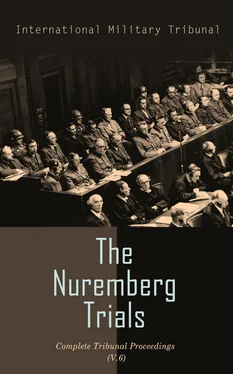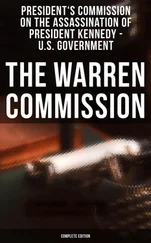1. By granting the “racial Germans” in Czechoslovakia a supreme order of citizenship—and I give the official reference to the Decree of the Führer and Reich Chancellor concerning the Protectorate to which I just referred—and then;
2. An act concerning the representation in the Reichstag of Greater Germany by German nationals resident in the Protectorate, 13 April 1939;
3. An order concerning the acquisition of German citizenship by former Czechoslovakian citizens of German stock, 20 April 1939.
Then there was a series of decrees that granted “racial Germans” in Czechoslovakia a preferred status at law and in the courts:
1. An order concerning the Exercise of Criminal Jurisdiction in the Protectorate of Bohemia and Moravia, 14 April 1939;
2. An order concerning the Exercise of Jurisdiction in Civil Proceedings, 14 April 1939;
3. An order concerning the Exercise of Military Jurisdiction, on 8 May 1939.
Then the orders also granted to the Protector broad powers to change by decree the autonomous law of the Protectorate. That is contained in the Ordinance on Legislation in the Protectorate, 7 June 1939.
And finally the Protector was authorized to go with the Reich Leader SS and the Chief of the German Police to take, if necessary, such police measures which go beyond the limits usually valid for police measures.
In view of the form of the order itself the Tribunal, if it cares to listen and to take judicial notice of this, in the Reichsgesetzblatt we have found inserted that one in the document book at Page 131, which rather staggers the imagination to know what can be police measures even beyond the limits usually valid for police measures when one has seen police measures in Germany between 1933 and 1939. But if such increase was possible, and presumably it was believed to be possible, then an increase was given by the Defendant Von Neurath and used by him for coercion of the Czechs.
The declared basic policy of the Protectorate was concentrated upon the central objective of destroying the identity of the Czechs as a nation and absorbing their territory into the Reich; and if the Tribunal will be good enough to turn to Page 132, they will find Document Number 862-PS, Exhibit USA-313, and I think that has been read to the Tribunal. Still, the Tribunal might bear with me so that I might indicate the nature of the document to them.
This memorandum is signed by Lieutenant General of Infantry Friderici. It is headed “The Deputy General of the Armed Forces with the Reich Protector in Bohemia and Moravia.” It is marked “Top Secret,” dated 15 October 1940. That is practically a year before this Defendant Von Neurath went on leave, as he puts it, on 27 September 1941; and it is called the “Basic Political Principles in the Protectorate,” and there are four copies. It also had gone to the Defendant Keitel and the Defendant Jodl, and it begins: “On 9 October of this year”—that is 1940:
“On 9 October of this year the Office of the Reich Protector held an official conference in which State Secretary SS Gruppenführer K. H. Frank”—that is not the Defendant Frank, it is the other K. H. Frank—“spoke about the following:
“Since creation of the Protectorate of Bohemia and Moravia, party agencies, industrial circles, as well as agencies of the central authorities of Berlin have been considering the solution of the Czech problem.
“After careful deliberation, the Reich Protector expressed his view about the various plans in a memorandum. In this, three possibilities of solution were indicated:
“a. German infiltration of Moravia and withdrawal of the Czech part of the people to a remainder of Bohemia. This solution is considered as unsatisfactory, because the Czech problem, even if in a diminished form, will continue to exist.
“b. Many arguments can be brought up against the most radical solution, namely, the deportation of all Czechs. Therefore the memorandum comes to the conclusion that it cannot be carried out within a reasonable space of time.
“c. Assimilation of the Czechs, that is, absorption of about half of the Czech people by the Germans, to the extent that it is of importance from a racial or other standpoint. This will be brought about, among other things, also by increasing the Arbeitseinsatz of the Czechs in the Reich territory, with the exception of the Sudeten German border districts—in other words, by dispersing the block of Czech people. The other half of the Czech nationality must by all possible ways be deprived of its power, eliminated, and shipped out of the country. This applies particularly to the racially mongoloid parts and to the major part of the intellectual class. The latter can scarcely be converted ideologically and would represent a burden by constantly making claims for the leadership over the other Czech classes and thus interfering with a rapid assimilation.
“Elements which counteract the planned Germanization are to be handled roughly and should be eliminated.
“The above development naturally presupposes an increased influx of Germans from the Reich territory into the Protectorate.
“After a report, the Führer has chosen solution c (assimilation) as a directive for the solution of the Czech problem and decided that, while keeping up the autonomy of the Protectorate outwardly, Germanization will have to be carried out uniformly by the Office of the Reich Protector for years to come.
“From the above no specific conclusions are drawn by the Armed Forces. It is the way that has always been followed. In this connection, I refer to my memorandum which was sent to the Chief of the Supreme Command of the Armed Forces, dated 12 July 1939, entitled ‘The Czech Problem.’ ”
And that is signed, as I said, by the Deputy Lieutenant General of the Armed Forces.
That view of the Reich Protector was accepted and formed a basis of his policy. The result was a program of consolidating German control over Bohemia and Moravia by the systematic oppression of the Czechs through the abolition of civil liberties and the systematic undermining of the native political, economic, and cultural structure by a regime of terror, which will be dealt with by my Soviet Union colleagues. They will show clearly, I submit, that the only protection given by this defendant was a protection to the perpetrators of innumerable crimes.
I have already drawn the attention of the Tribunal to the many honors and rewards which this defendant received as his worth, and it might well be said that Hitler showered more honors on Von Neurath than on some of the leading Nazis who had been with the Party since the very beginning. His appointment as President of the newly created Secret Cabinet Council in 1938 was in itself a new and singular distinction. On 22 September 1940 Hitler awarded him the War Merit Cross 1st Class as Reich Protector for Bohemia and Moravia. That is in the Deutsches Nachrichtenbüro, 22 September 1940.
He was also awarded the Golden Badge of the Party and was promoted by Hitler, personally, from the rank of Gruppenführer to Obergruppenführer in the SS on 21 June 1943. And I also inform the Tribunal that he and Ribbentrop were the only two Germans to be awarded the Adlerorden, a distinction normally reserved for foreigners. On his seventieth birthday, 2 February 1943, it was made the occasion for most of the German newspapers to praise his many years of service to the Nazi regime. This service, as submitted by the Prosecution, may be summed up in two ways:
1) He was an internal Fifth Columnist among the Conservative political circles in Germany. They had been anti-Nazi but were converted in part by seeing one of themselves, in the person of this defendant, wholeheartedly with the Nazis;
2) His previous reputation as a diplomat made public opinion abroad slow to believe that he would be a member of a cabinet which did not stand by its words and assurances. It was most important for Hitler that his own readiness to break every treaty or commitment should be concealed as long as possible, and for this purpose he found in the Defendant Von Neurath his handiest tool.
Читать дальше












